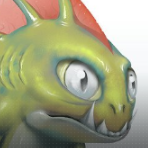-
Posts
6 -
Joined
-
Last visited
Reputation Activity
-
 PukkaFactor got a reaction from Harry_ in MSI/EXE or refund?
PukkaFactor got a reaction from Harry_ in MSI/EXE or refund?
This is welcome news. I have a Logitech mouse with a lot of programmable buttons I use for 2D and 3D programs. When first setting up a profile, the Logitech G-Hub software needs the user to select the file path of the Affinity Photo exe to switch to the Affinity profile when the program is active. Almost impossible to do without taking ownership of the "WindowsApps" folder to gain access to the Affinity install directory and file path.
-
 PukkaFactor reacted to Leigh in Is it possible to change the Installation Path when installing Affinity V2?
PukkaFactor reacted to Leigh in Is it possible to change the Installation Path when installing Affinity V2?
If you've purchased Affinity V2 for Windows directly from the Affinity Store, you will have downloaded an MSIX package. You will notice when installing Affinity V2 you will not be offered the ability to change the installation path. This is expected and is down to how MSIX packages work. All Windows Apps are installed to the default drive set in Settings > System > Storage.
There are two options to change where Affinity V2 is installed to:
Temporarily change "Where new content is saved" by going to Settings > System > Storage > More / Advanced Storage Settings > Change where new contact is saved and select the required drive from the New apps will save to: dropdown menu. Once you've installed the app to the new drive, you can revert this setting back to Local Disk (C:)
Move the app to a different drive once installed by going to Settings > Apps > Apps & Features selecting the Affinity App and clicking Move Please note: It's only possible to pick the drive where you want the app installed to but not the full location. Unfortunately, this is handled by Windows and cannot be changed by the user.
-
 PukkaFactor reacted to James Ritson in 32bit & 16bit workflows as compared to Photoshop
PukkaFactor reacted to James Ritson in 32bit & 16bit workflows as compared to Photoshop
Hi @CJI, I'll do my best to address the issues you've raised. I do a lot of 3D retouching work from Blender and 3ds Max/V-ray (EXR output) so will hopefully be able to give you a few pointers here.
First of all, I assume you're using OpenEXR or Radiance HDR formats in 32-bit? 32-bit in Photo is obviously a little bit different as it's not just linear but also unbounded, whereas Photo's 16-bit and 8-bit formats are gamma corrected and bounded. This probably means there are two main points to address: tone mapping and compositing.
How would you usually achieve tone mapping in Photoshop? In Photo, one option is to use the Tone Mapping Persona (not Develop), which will give you methods of mapping unbounded values to within the 0-1 range. You can also use OpenColorIO transforms—for example, with Blender, you can apply the Filmic view transform and looks. I did a video on that a couple of months ago:
You can also try various adjustments for a more manual approach—the Exposure slider to shift extreme highlights down, for example, then Curves and Levels with a gamma adjustment.
This brings me onto compositing—everything operates in linear space (scene linear) within 32-bit, then you have a gamma corrected view transform applied afterwards. It does mean that adjustments in particular may behave differently or seem more "sensitive".
Photo allows you to use pretty much the entire roster of tools, adjustments and filters (with the exception of median operators) in 32-bit, but there are a few caveats. Most adjustments should avoid clipping or bounding values, but pre-tone mapping I would stick to Exposure, Curves, White Balance, Channel Mixer, Levels etc. Brightness & Contrast will only operate on a 0-1 value range, but won't clip any unbounded values, and Curves will operate on the 0-1 range by default but you can change the minimum and maximum input values—so if you wanted to only manipulate bright values above 1, for example, you can set minimum to 1 and maximum to 100 (or whatever the brightest value is in your document).
Adjustments like HSL, Selective Colour and others that tend to focus on colour manipulation are best saved post-tone mapping, where your pixel values will be in the 0-1 range. If you use OCIO adjustment layers (or check out my Blender Filmic macros which do away with the OCIO dependency) you can add these adjustments above the tone mapping layers or group. If you want to use the Tone Mapping Persona, I'd advise you to do Layer>Merge Visible and then tone map the merged pixel layer, then put your adjustments above this.
Hopefully by following the above advice, you'll avoid the clipping and washing out that you describe. I suspect you may not have tone mapped your image and are trying to use adjustments like HSL, Selective Colour on the linear values? Converting to 16-bit at this point will not help the issue, since unbounded values outside 0-1 will be clipped. You need to tone map first using methods described above, then you can manipulate colour freely.
That said, as I've covered above, there are certain colour manipulations you can do on the linear values pre-tone map. Channel Mixer, for example, won't clip values, nor will White Balance. I also do a lot of stacked astrophotography editing in 32-bit linear, and sticking a White Balance adjustment before tone stretching is a really powerful way of neutralising background colour casts. It's useful with render compositing too since you can completely shift the temperature and tint without introducing artefacting.
One final caveat, then—have you configured OpenColorIO at all with your Photo setup? This throws people off, because when you do have it configured, opening an EXR or HDR document will default to the OCIO transform method (the final document to screen conversion) rather than ICC-based. This is great if you intend to export back to EXR/HDR and simply want to do some retouching work, but if you plan to export from Photo to a standard delivery format like TIFF/PNG/JPEG etc you need to be using ICC Display Transform for an accurate representation. You can configure this on the 32-bit Preview Panel (View>Studio>32-bit Preview).
To follow on from this, you mentioned profiles at the bottom of your post—I think you might be referring to document profiles etc? Don't get too hung up on this—in linear unbounded, the colour profile is somewhat arbitrary, and is only used with ICC Display Transform to convert and bound the linear values you're working with into gamma corrected values. With Unmanaged or OpenColorIO view options, this profile does not matter. If you're aiming for web delivery, stick to sRGB (Linear) with ICC Display Transform set and everything will be fine!
Apologies for the small essay, hope you find all the above useful.
-
 PukkaFactor reacted to James Ritson in Multilayer EXR export error
PukkaFactor reacted to James Ritson in Multilayer EXR export error
Hi again, I think the export error is because of your layer stack. Check out the help topics on OpenEXR at https://affinity.help — particularly this one:
https://affinity.help/photo/English.lproj/pages/HDR/openexr.html
Generally, all of your pixel layers should have an .RGB or .RGBA affix (for example "Layer02.RGB" or "Layer02.RGBA" if it has a distinct alpha channel). If you don't specify layers as RGB pixel data they will be discarded on export.
The reason you have to do this is because Affinity Photo has lots of different layer types: pixel layers, image layers, curves, fills, groups, etc. The OpenEXR spec is much narrower and you have to dictate what type of channel information each layer becomes when exporting to EXR. If you don't specify the channel type, Photo will ignore or discard the layer in question during export.
If you have a pixel layer with a mask inside it, you must use the .RGBA prefix if you want to export the alpha channel separately—if you just use .RGB the alpha channel will be baked into the pixel layer and will be non-editable.
Separate colour channel information can also be exported, so you could affix layers with .R, .B, .G and .A etc and they will be stored as individual channels in the EXR document.
You don't appear to be working with any spatial layers like .Z or .XYZ so you can probably ignore them.
Embedded documents and placed images should be correctly rasterised as long as you give them an .RGB or .RGBA prefix.
Groups you will have to rasterise, even if you give them an .RGB prefix, otherwise they won't export. Right click the group and choose Rasterise to do this (make a duplicated backup beforehand and hide it though).
I'm actually struggling to reproduce the error message now—if you try the naming conventions listed above and are still getting the error message, please could I send you a private Dropbox link to upload the document so I can have a look? It would only be used internally and then deleted once the issue is addressed.
Thanks and hope the above helps,
James
-
 PukkaFactor got a reaction from Frozen Death Knight in Improvements for Game Art (Video)
PukkaFactor got a reaction from Frozen Death Knight in Improvements for Game Art (Video)
This is what I do most of the time with other software. I never dreamed Affinity would be developing something like this. This is a great start to a potentially huge market. If this ever comes close to SP you will have legions of Adobe deserters paying for this app. Sign me up for the beta!
-
 PukkaFactor reacted to Ash in Affinity Photo for iPad wins App of the Year 2017!
PukkaFactor reacted to Ash in Affinity Photo for iPad wins App of the Year 2017!
Hi All,
We're over the moon to announce that Apple have selected Affinity Photo for iPad as their App of the Year 2017!
We weren’t really sure this year could have got any better. From our big launch on stage at WWDC in June, to all the amazing reviews and feedback we’ve had from many of you – we’ve been totally blown away by the response our app has had. It's important to say that to create an app like this has only been possible with all your support. Not just help with the beta and development of the app itself, but in making Affinity such a success over the last few years to enable us to invest in the development of a big project like this.
If you haven't yet got the iPad version of Affinity Photo we are running a flash sale, just for the next 48 hours, to get it with a 50% discount. We can't imagine running such a big discount again for a very long time(!) so don't miss out on that. More info on our iPad page here.
Also we'd love you to help spread the word about this for us. It's been a while since we've done a competition like this, so if you:
Like our Facebook page and share or comment on this post
or
Follow us on Twitter and retweet this tweet
You'll be entered into a free draw to win a 12.9" iPad Pro! The closing date is 12pm GMT on Saturday (when the flash sale ends), and we'll announce the winner on this thread.
But more than anything, thanks again for all your continued support.
Ash
Edit by Patrick.
The Winner of the iPad (mentioned in this post) is in a reply to this thread here
-
 PukkaFactor reacted to leifm in New Intuos and Intuos Pro
PukkaFactor reacted to leifm in New Intuos and Intuos Pro
I just got the 13. Put up a quick demo here with Affinity Photo :)
https://youtu.be/vBmTHac2RUs
I made a playlist with a rundown and connection also.,



